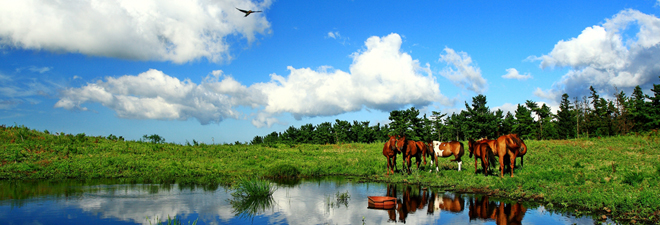Public enterprise working for the happiness of all through tourism, JTO
Jeju in the World
HOME > Jeju in the World > Bio Sphere Reserve
Bio Sphere Reserve
-

-

-
- Designated Date :
- December 16, 2002 , designated a World Biosphere Reserve on June 27, 2007 and registered as Korea’s first World Natural Heritage Property with the title of Jeju Volcanic Island and Lava Tubes
- Geographical Location :
- Jeju Island consists of two streams located in the center of the Island and three islets in the southern part of the Island. The highest elevation is 1,950m, which is the summit of Mt. Halla and the Maximum depth of the coastal and marine areas is 74m below sea level at the coastal area southwest of Munseom (Islet).
- Biogeographical Province :
- sub-tropical and temperate rainforest
- Latitude :
- Central point (top of Mt. Halla) 33° 21'29''N, 126° 31'53''E Outer boundary of buffer zone 33° 17'34''N ~ 33° 26'44''N, 126° 23'6''E-126° 40'29'' Marine Part 33° 12'27''N ~ 33° 13'56''N, 126° 30'2''E-126° 36'38''
- Area :
- 830.94 ha
- Altitude :
-
-74m ~ 1950m The Highest elevation: 1,950m (summit of Mt. Halla)
The lowest elevation: 0m (Coastal)
The Maximum depth below sea level at the coastal/marine
areas: 74m (southwest of Munseom Islet).
-
- Climate :
- Jeju Island has an oceanic climate due to the effects of monsoons since it is located in the east of the Asian Continent and surrounded by the sea. In addition, a special subtropical moist climate exists at the summit of Mt. Halla, at the center of the island, caused by the oceanic current flowing near the island. The annual mean air temperature of the summit of Mt. Halla is 3.7℃ the vertical distribution of climatic zones from subtropical to subarctic climates is well illustrated on Mt. Halla. The annual mean precipitation is 1,400 mm but areas in the southeast have more than the northwestern areas. In addition, precipitation increases along with the elevation, so the annual precipitation of Seongpanak(750m) in Mt. Halla National Park exceeds 2,000mm
- Physical Features :
- Mt. Halla, as a core area, is located in the center of Jeju Island and is the highest mountain (1,950m) in South Korea. It is a shield volcano formed from cumulative basaltic lava flows. The eastern part of the crater is partially filled with water and composed of a crater lake, Baekrokdam. On Jeju Island there are 368 small parasitic volcanoes called ‘Oreum’ in the typical Jeju dialect. About 46 parasitic volcanoes exist within Mt. Halla National Park and approximately 260 are scattered in areas above 200m in elevation. Rivers show a radial drainage pattern by centering on Mt. Halla however; most of the rivers belong to dry streams. Small scale wetlands have developed in some craters of the parasitic cones. In particular, mountain wetlands are formed around Sallok (1,100m) in the western part of Mt. Halla




